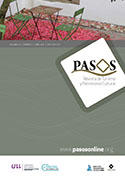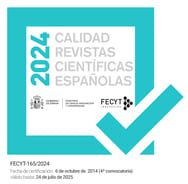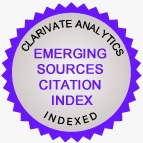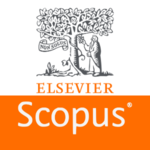The correspondence between the construction of authentic experiences and the interpretation of heritage. Reflections from the point of view of existential authenticity
DOI:
https://doi.org/10.25145/j.pasos.2016.14.032Keywords:
cultural heritage, authenticity, heritage experiencie, cultural tourism, tourism demandAbstract
This article addresses the relationship between the concept of authenticity and cultural heritage. We analyze the meeting points between both terms that are considered key to understand the different cultural tourism nowadays, characterized by the special relevance that is attributed to the emotional and sensorial component. These experiences are framed within the new behavioural and motivational trends that can be observed from the side of tourist demand, which are the result of the social context that determines the characteristics of tourists, their preferences and the tourist practices they wish to develop, in which the sensorial and emotional component constitutes one of the most relevant aspects that can define contemporary cultural tourism. In this sense, it highlights the obvious possibilities offered by the interpretation of heritage for the creation of heritage experiences that could be called authentic.
Downloads
Publication Facts
Reviewer profiles N/A
Author statements
- Academic society
- PASOS. Revista de Turismo y Patrimonio Cultural
- Publisher
- Instituto Universitario de Investigación Social y Turismo. Universidad de La Laguna (España) - Instituto Universitario da Maia ISMAI (Portugal)
References
Álvarez Sousa, A. 2004. “Cambio social y ocio turístico en el siglo XXI. En Turismo, ocio y deporte: VIII Congreso de Sociología (pp. 15-41). Universidade da Coruña.
Andriotis, K. 2011. “Genres of heritage authenticity. Denotations from a pilgrimage landscape”. Annals of Tourism Research, 38 (4): 1613-1633.
Apostolakis, A. 2003. “The convergence process in heritage tourism”. Annals of Tourism Research, 30 (4): 795-812.
Augé, M. 998. “Un etnólogo en Disneylandia”. Boletín del Instituto Andaluz del Patrimonio Histórico, 25: 63-66.
Barvier-Bouvet, J.F. 1983. “El público. Evaluación, evoluciones”. La museología. Curso de museología. Textos y testimonios, Akal.
Bazán, H. 2014. “Los cambios de la definición de interpretación del patrimonio”. Boletín de Interpretación, 30: 11-14, Asociación para la Interpretación del Patrimonio. Fecha de acceso: 23/1/2015: http://www. interpretaciondelpatrimonio.com/boletin/index.php/boletin/article/viewfile/319/319
Bonmatí, C.; Espinosa, A.; Marí, Mª J y Lloret, M. 2008. “Veus de la història, una exposición interpretativa”: Boletín de Interpretación 18: 14-16. Asociación para la Interpretación del Patrimonio. Fecha de acceso: 22/1/2015: www.interpretaciondelpatrimonio.com
Bordas, E. 2003. “Hacia el turismo de la sociedad de ensueño: nuevas necesidades de mercado”. Inauguración del primer semestre del curso 2002-2003 de los estudios de Economía y Empresa de la UOC (2002: Bellaterra) [conferencia en línea]. UOC. Fecha de acceso: 16/1/2015. http://www.uoc.edu/dt/20219/
Campuzano, S. 2007. “Los sentidos de Itálica”. Boletín de Interpretación, 16: 12-13. Asociación para la Interpretación del Patrimonio. Fecha de acceso: 22/1/2015. http://www.interpretaciondelpatrimonio.com
Candelas, G. 2011. “El roscón de reyes”. Boletín de Interpretación, 25: 11-12. Asociación para la Interpretación del Patrimonio. Fecha de acceso: 22/1/2015. www.interpretaciondelpatrimonio.com
Cohen, E. y Cohen, S.A. 2012. “Current sociological theories and issues in tourism”. Annals of Tourism Research, 39 (4): 2177-2202.
Cuenca, M. 2007. “El turismo experiencial: nuevo horizonte para el desarrollo de valores”. En Desafíos y compromisos del turismo: hacia una visión más humana. Congreso UNIJES (pp. 311-332).
Cuenca, M. y Goytia, A. 2012. “Ocio experiencial: antecedentes y características”. Arbor. Ciencia, pensamiento y cultura, 188 (754): 265-281.
Chhabra, D. 2008. “Positioning museums on an authenticity continuum”. Annals of Tourism Research, 35 (2): 427-447.
Chhabra, D.; Healy, R. y Sills, E. 2003. “Staged authenticity and heritage tourism”. Annals of Tourism Research, 20 (3): 702-719.
Donaire, J.A. 2012. Turismo cultural. Entre la experiencia y el ritual. Girona: Edicions Vitel.la.
Escarpanter, A. 2011. “En busca del placer turístico: la interpretación del patrimonio como estrategia”. Boletín de Interpretación, 25: 5-6. Asociación para la Interpretación del Patrimonio. Fecha de acceso: 23/1/2015. http://www.interpretaciondelpatrimonio.com/
Espinosa, A. 2002a. “La accesibilidad física e intelectual de todo tipo de público al patrimonio cultural (I)”. Boletín de Interpretación, 6: 13-15. Asociación para la Interpretación del Patrimonio. Fecha de acceso: 24/1/2015. http://www.interpretaciondelpatrimonio.com/ 2002b. “La accesibilidad física e intelectual de todo tipo de público al patrimonio cultural (II)”. Boletín de Interpretación, 7: 4-6. Asociación para la Interpretación del Patrimonio. Fecha de acceso: 24/1/2015. http://www.interpretaciondelpatrimonio.com/ 2003. “Los nuevos tipos de museo a comienzos del siglo XXI y la interpretación del patrimonio cultural (I). Boletín de Interpretación, 9: 8-10. Asociación para la Interpretación del Patrimonio. Fecha de acceso: 24/1/2015. http://www.interpretaciondelpatrimonio.com/
Espinosa, A.; Bonmatí, C.; Marí, Mª J. y Lloret, M. 2009. “A la busca del más allá. Una exposición diferente”. Boletín de Interpretación, 20: 30-33. Asociación para la Interpretación del Patrimonio. Fecha de acceso: 23/1/2015. http://www.interpretaciondelpatrimonio. com/
European Travel Commission 2005. City, tourism and culture. The european experience, European Travel Commission and WTO. Brussels.
García Hernández, M. 2003. Turismo y conjuntos monumentales: capacidad de acogida turística y gestión de flujos de visitantes. Valencia: Tirant Lo Blanch.
Gorgas, M. y de la Cerda, J. A. 2005. “Diferentes denominaciones, diferentes ideologías: pero siempre se trata de gente”. Museology and audience. ICOFOM Study Series: 69-96. Munich.
Ham, S. 2005. “Audiencias cautivas y no cautivas. Un relato de cómo llegué a esa idea y a qué me refiero con esto”. Boletín de Interpretación, 13: 2-4: Asociación para la Interpretación del Patrimonio. Fecha de acceso: 24/1/2015. http://www.interpretaciondelpatrimonio.com 2007. “¿Puede la interpretación marcar una diferencia?. Respuestas a cuatro preguntas de psicología cognitiva y del comportamiento”. Boletín de Interpretación, 17: 10-16. Asociación para la Interpretación del Patrimonio. Fecha de acceso: 24/1/2015. http://www.interpretaciondelpatrimonio.com 2008. “De la interpretación a la protección: ¿hay una base teórica?”. Boletín de Interpretación, 18: 27-31. Asociación para la Interpretación del Patrimonio. Fecha de acceso: 24/1/2015. http://www. interpretaciondelpatrimonio.com 2011. “La interpretación es persuasiva cuando el tema es convincente”. Boletín de Interpretación, 25: 18-20. Asociación para la Interpretación del Patrimonio. Fecha de acceso: 24/1/2015. http://www. interpretaciondelpatrimonio.co 2014. “Un poco de psicología ayuda mucho”. Boletín de Interpretación, 29: 17-20. Asociación para la Interpretación del Patrimonio. Fecha de acceso: 24/1/2015. http://www.interpretaciondelpatrimonio.com
Hernández Hernández, F. 2007. “La museología ante los retos del siglo XXI”. Revista de Patrimonio Histórico, 1: 333-359 Universidad de Granada. 2011. “Museo dialógico y comunicación social”. El museo dialógico y la experiencia del visitante. ICOFOM Study Series, 40: 107-115.
Jacobi, D. 2011. “A propósito del dialogismo en los museos”. El museo dialógico y la experiencia del visitante. ICOFOM Study Series, 40: 21-23.
Kohl, J. 2013. “¿Qué es realmente real? Nueva visión de la autenticidad y su papel en la interpretación y el turismo alternativo”. Boletín de Interpretación, 27: 21-24. Asociación para la Interpretación del Patrimonio. Fecha de acceso: 22/1/2015. http://www.interpretaciondelpatrimonio.com/boletin/index. php/boletin/article/viewfile/295/295 2004. “Mensajes poderosos hacen presentaciones memorables”. Fecha de acceso: 22/1/2015. http://www. jonkohl.com/publications/categories/spanish.htm
Kolar, T. y Zabkar, V. 2010. “A consumer-based model of authenticity: an oximoron or the foundation of cultural heritage marketing?”. Tourism Management, 31: 652-664.
Larsen, D. 2007. “Ser relevante al público o convertirse en una reliquia. Ir al encuentro del público en su propio terreno”. Boletín de Interpretación, 16: 18-23. Asociación para la Interpretación del Patrimonio. Fecha de acceso: 22/1/2015. http://www.interpretaciondelpatrimonio.com/
Leroux-Dhuys, J.F. 1993. “George Henri Rivière, un hombre en su siglo”. La museología. Curso de museología. Textos y testimonios, Akal.
Leyra Landeira, G. 2013. “Dream society and changes in tourist activity”. Rotur. Revista de ocio y turismo, 6: 76-90, Fecha de acceso: 24/1/2015. http://www.rotur.es
Lezcano González, M. 2011. “El sanatorio de Riazor, una auténtica experiencia interpretativa”, Boletín de Interpretación, 25: 13-14. Asociación para la Interpretación del Patrimonio. Fecha de acceso: 24/1/2015. http://www. interpretaciondelpatrimonio.com/
Lorente Lorente, J.P. 2006. “Nuevas tendencias en teoría museológica: a vueltas con la museología crítica”, Museos.es. Revista de la Subdirección de Museos Estatales, 2: 24-33. 2012. “Museología crítica: museos y exposiciones como espacios públicos de controversia y participación colectiva”. Revista art.es, 52: 98-103.
Luque, M. 2001. “Atapuerca en braille y lengua de signos”. Boletín de Interpretación, 5: 3-5. Asociación para la Interpretación del Patrimonio. Fecha de acceso: 22/1/2015. http://www.interpretaciondelpatrimonio.com/
Mallor, E.; González Gallarza, M. y Fayos Gardó, T. 2013. “¿Qué es y cómo se mide en turismo cultural?. Un estudio longitudinal con series temporales para el caso español”. Pasos. Revista de Turismo y Patrimonio Cultural, 11 (2): 269-284.
Morales, J. 1998. Guía práctica para la interpretación del patrimonio. El arte de acercar el legado natural y cultural al público visitante. Sevilla: Conserjería de Cultura. 2004. “La interpretación en su acepción de comunicación atractiva in situ”. Boletín de Gestión Cultural. Portal Iberoamericano de Gestión Cultural, 8. Fecha de acceso: 22/1/2015: http://www.gestioncultural. org/ficheros/1_1316767039_jmorales-interpreta.pdf 2008. “El sentido y la metodología de la interpretación del patrimonio”. En Mateos Rusillo (Coord.) La comunicación global del patrimonio cultural Gijón: Trea. 1999. “Una lección de Don Aldridge”. Boletín de Interpretación, 1: 21. Asociación para la Interpretación del Patrimonio. Fecha de acceso: 23/1/2015: http://www.interpretaciondelpatrimonio.com
Morales, J. y Ham, S. 2008. “¿A qué interpretación nos referimos?”. Boletín de Interpretación, 19: 4-7. Asociación para la Interpretación del Patrimonio. Fecha de acceso: 22/1/2015. http://www.interpretaciondelpatrimonio.com
Moscardo, G. 1996. “Mindful visitors, heritage and tourism”. Annals of Tourism Research, 23 (2): 376-397.
Nicolau Gonzálbez, J. L. 2009. “Determinantes de la motivación cultural en la elección de destinatarios: el caso español”, Revista de Patrimonio Histórico, 5: 317-326. Universidad de Granada.
Nuryanti, W. 1996. “Heritage and postmodern tourism”. Annals of Tourism Research, 23 (2): 249-260.
Pérez Santos, E. 2000. Estudio de visitantes en museos. Metodología y aplicaciones. Gijón: Trea.
Poria, Y.; Butler, R. y Airey, D. 2003. “The core of heritage tourism”. Annals of Tourism Research, 30 (1): 238-254.
Poria, Y.; Reichel, A. y Biran, A. 2006a. “Heritage site management. Motivations and expectations”. Annals of Tourism Research, 33 (1): 162-178. 2006b. “Heritage site perceptions and motivations to visit”. Journal of Travel Research, 44 (3): 317-326.
Reisinger, Y. 2006. “Reconceptualizing object authenticity”. Annals of Tourism Research, 33 (1): 65-86.
Richards, G. 1996a. “Production and consumption of european cultural tourism”. Annals of Tourism Research, 23 (2): 261-283. 1996b. Cultural tourism in Europe. Wallingford: CAB International. 2001. “El desarrollo del turismo cultural en Europa”. Estudios turísticos, 150: 3-13. Instituto de Estudios Turísticos. 2002. “Tourism attraction systems: exploring cultural behavior”. Annals of Tourism Research, 2 (4): 1048-1064.
Santacana, J. 2010. Introducción al análisis de modelos de museografía interactiva. En Santacana, J. y Martín Piñol, C. (coords.), Museografía interactiva (pp. 25-86). Gijón: Trea.
Santana Talavera, A. 2003a. “Patrimonios culturales y turistas: unos leen lo que otros miran”. Pasos. Revista de Turismo y Patrimonio Cultural, 1 (1): 1-12. 2003b. “Mirar y leer: autenticidad y patrimonio cultural para el consumo turístico. En Nogués, A. M. (coord.), Cultura y turismo. Conserjería de Cultura de la Junta de Andalucía. Sevilla: Demos.
Serantes, A. 2007. “Cuando lo importante es el guía: Fisterra, pescando donde se pone el sol”. Boletín de Interpretación, 17: 9, Asociación para la Interpretación del Patrimonio. Fecha de acceso: 22/1/2015. www. interpretaciondelpatrimonio.com
Silberberg, T. 1995. “Cultural tourism and business opportunities for museums and heritage sites”. Tourism Management, 16 (5): 361-365.
Steiner, C. y Reisinger, Y. 2006. “Understanding existencial authenticity”. Annals of Tourism Research, 33 (2): 299-318.
Tilden, F. 2006. La interpretación de nuestro patrimonio. Asociación para la Interpretación del Patrimonio: Burgos.
Urry, J. 2008. “La globalización de la mirada del turista”. Barcelona Metrópolis. Revista de información y pensamientos urbanos, 72: 49-57. 2005. Sociologie des mobilités. Une nouvelle frontière pour la sociologie? Armand Colin: París.
Van der Ark, L. A.; Richards, G. 2006. “Attractiveness of cultural activities in european cities: a latent class aproach”. Tourism Management, 27: 1408-1413.
Waitt, G. 2000. “Consuming heritage. perceived historical authenticity”. Annals of Tourism Research, 27 (4): 835-862.
Wang, N. 1999. “Rethinking authenticity in tourism experience”. Annals of Tourism Research, 26 (2): 349-370.
Yeoman, I.; Rebeca, T.L.Y.; Mars, M y Wouters, M. 2012. “Tomorrow’s tourist: fluid and simple identities”. En 2050 tomorrow’s tourism. Aspects of tourism (pp. 50-62). Channel View Publications: Bristol.
Yeoman, I.; Brass, D. y Mcmahon-Beattie, U. 2007. “Current issue in tourism: the authentic tourist”. Tourism Management, 28: 1128-1138.
Downloads
Published
How to Cite
Issue
Section
License
I confirm that the work is original (of my/our authorship), and that it will not be submitted to other journals or publications until the final resolution of the review process in PASOS, RTPC.
I authorize the publication of my work by PASOS, PSTN of free and open access in any of the formats that I deem appropriate, for an indefinite period of time and as a non-remunerated collaboration.
Likewise, the author(s) understands that the published work may be linked or deposited on any server or included in other publications (republication), provided that the new place and/or new edition references the original publication and acknowledges the authorship and copyright ownership of PASOS RTPC publications.
Authors understand that a plagiarism-self-plagiarism check will be performed, and the article may be removed at any time from the editorial flow.










